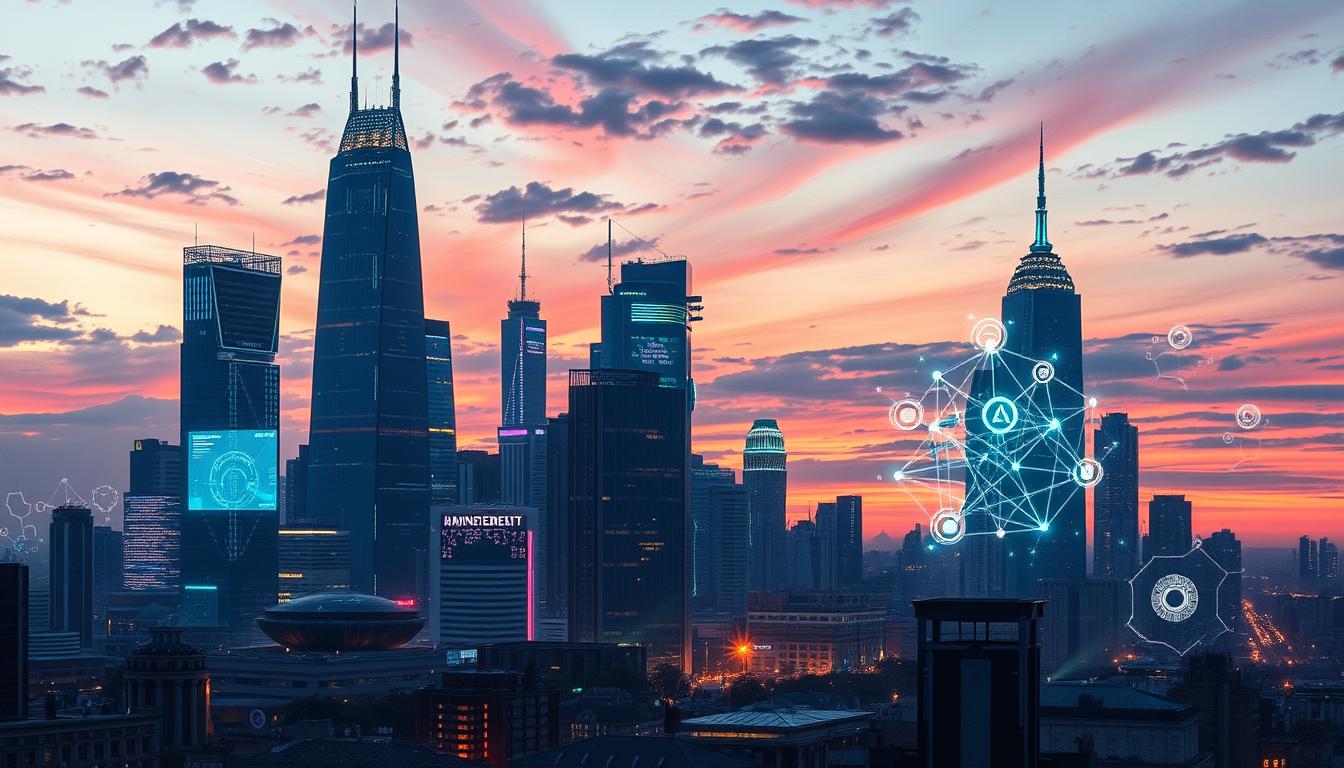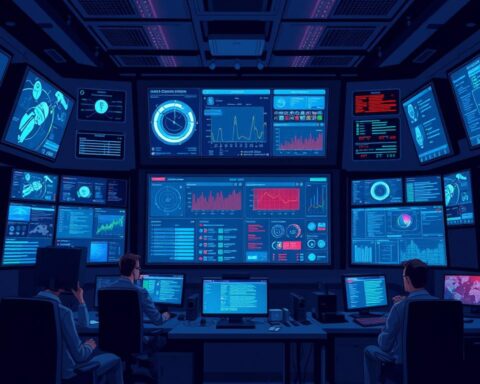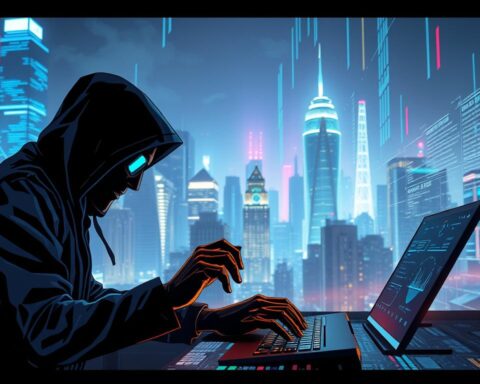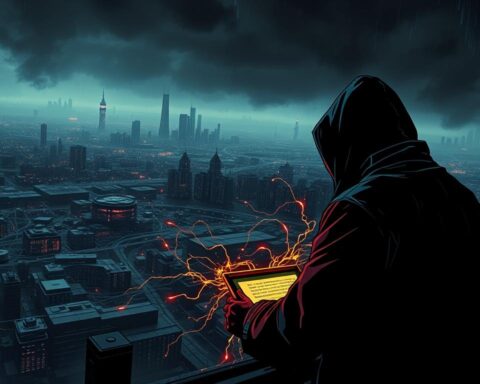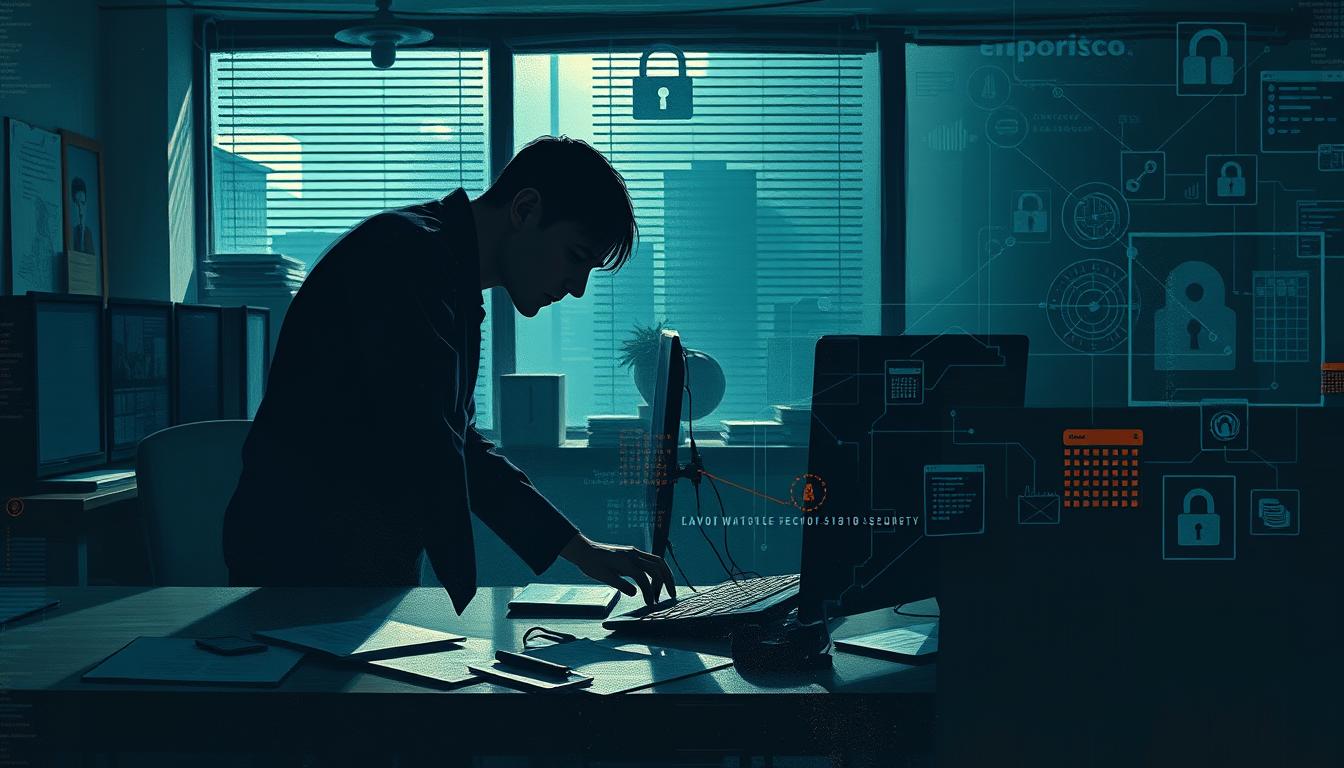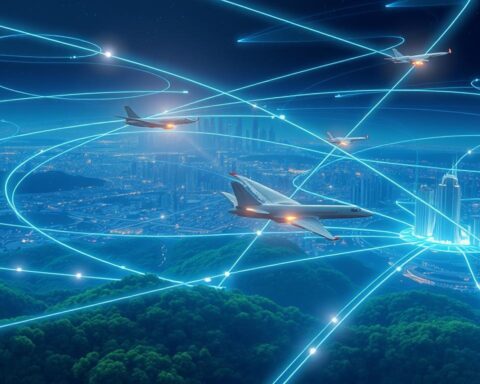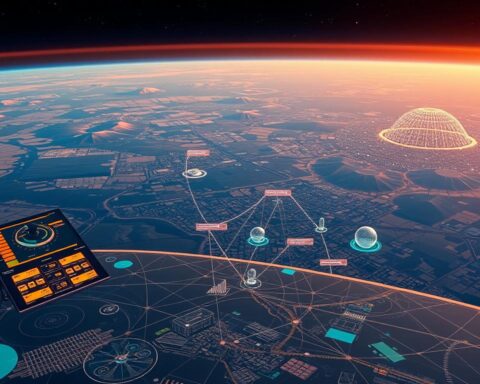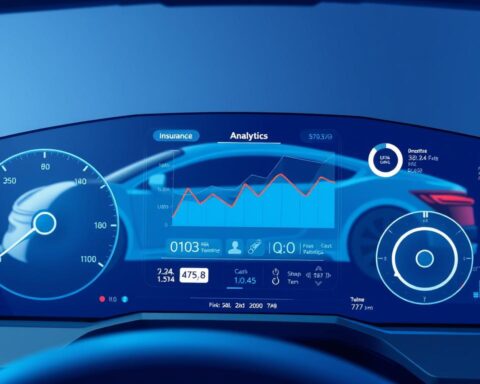AI-powered cyber attacks happen about 2,200 times every day worldwide. Around 40% of cyberattacks use AI1. This shows how fast cybersecurity is changing, with AI and quantum computing making new threats and defenses.
Cybersecurity faces big challenges today. Almost 50% of companies worry about AI-enhanced cybercrime2. Old security methods are struggling against new, smart digital threats.
AI and quantum computing are real and urgent issues. Ransomware attacks could cost $30 billion this year. Also, 66% of companies faced ransomware in 20221.
We’re looking at how AI and quantum computing will change digital security. This includes AI for finding threats and quantum-safe encryption. Our goal is to help cybersecurity experts and companies deal with these new challenges.
Key Takeaways
- AI-powered cyber attacks are becoming increasingly prevalent
- Quantum computing poses both threats and opportunities for cybersecurity
- Organizations are struggling with workforce shortages in cybersecurity
- The financial impact of cybercrime is escalating rapidly
- Preparation for quantum-resistant encryption is critical
- AI and machine learning are reshaping threat detection and response
- Global alignment on cybersecurity standards is becoming essential
Understanding the Modern Cybersecurity Landscape
The world of cyber threats is changing fast. This is thanks to new technologies and global politics. Companies are facing big challenges to keep their digital stuff safe from smart attacks.
The Emergence of New Cyber Threats
Now, AI is helping bad guys with their plans. These smart attacks can hit more places and be more precise. In 2024, companies that didn’t act fast saw a 60% jump in security problems3.
This means even small businesses are now at risk. They used to be safer than big ones.
Impact of Geopolitical Tensions
Global politics are changing how we fight cyber threats. Almost 60% of companies say world events affect their security plans. This has made them work together more to tackle big security issues4.
Current State of Global Cyber Defense
The world is getting better at fighting cyber threats. AI helps by making things run smoother and spotting dangers faster. It can look at lots of data quickly to find and stop attacks4.
Companies are using many ways to stay safe. They include:
- AI for predicting threats
- Tools to watch for odd behavior
- Training for employees
- Zero Trust Architecture
To stay ahead, companies need to be proactive. They must keep up with digital changes brought by quantum computing and AI4.
The Future of Cybersecurity: AI, Quantum Computing, and Beyond
The world of cybersecurity is on the verge of a big change. Artificial intelligence and quantum computing are going to change how we defend our digital world. These new tools will help us spot and fight threats better. But, they also bring new problems.
Google’s Willow quantum chip shows how powerful quantum computing is. It can solve hard problems in seconds, while old computers would take years or even millennia5. This is both exciting and scary for cybersecurity.
By 2030, AI and machine learning will be key in keeping our digital world safe. They’ll help find new threats early by analyzing lots of data fast6. But, we also expect to see smarter attacks, like advanced malware and automated hacking.
Quantum computers are a big worry for our current encryption. They could break today’s encryption in just minutes, putting our data at risk5. This has started a race to find new, safe ways to protect our data.
“Quantum-readiness” is becoming a priority for industries reliant on long-term data confidentiality.
The future of cybersecurity is not just about fighting threats. IBM’s plans show how quantum computing will grow from a 5-qubit machine in 2017 to a 100,000-qubit machine by 20337. This could change how businesses work, make AI faster, and introduce new ways to encrypt data like “entropic encryption.”
Looking ahead, other new technologies will also change cybersecurity. Edge computing, IoT devices, and serverless computing will need new security rules6. The future of cybersecurity is about keeping up with these new threats and using the latest tech to stay ahead.
Artificial Intelligence’s Role in Cybersecurity Evolution
Artificial intelligence is changing how we fight cyber threats. It brings new tools for finding and stopping attacks. From simple viruses to today’s AI systems, cybersecurity has grown a lot8.
AI-Powered Threat Detection Systems
AI has made threat detection much better. These systems check billions of data points every hour. This is a big jump from old methods9.
Machine Learning in Predictive Security
Machine learning has changed cybersecurity from just reacting to stopping threats before they happen. It learns what normal behavior is and stops threats before they start. This cuts down cyber threats by up to 40%89.
Automated Response Mechanisms
AI has made responding to threats much faster. Companies using AI solutions see their response times drop by 60%9. This lets security teams do more important work, with routine tasks down by 70%9.
| AI Impact Area | Improvement |
|---|---|
| Threat Detection Rate | 30% increase |
| Threat Impact Reduction | Up to 40% |
| Routine Task Reduction | 70% |
| Incident Response Time | 60% reduction |
As AI gets better, it will play an even bigger part in keeping us safe online. With more investment, AI will help make our cybersecurity stronger.
Quantum Computing: Revolutionary Threats and Opportunities
Quantum computing is leading the way in tech, changing how we protect digital info. It brings big challenges and new chances for keeping data safe.
Post-Quantum Cryptography
Quantum computers are a big worry for today’s encryption. They can solve problems in hours that take old computers years. This means RSA encryption might not be safe anymore, as quantum computers can break it in minutes10.
To fight this, experts are working on new encryption methods. The National Institute of Standards and Technology (NIST) is leading the effort to make encryption safe from quantum computers1011. This is urgent because hackers might already be saving encrypted data for when quantum computers are ready10.
Quantum-Safe Security Measures
Companies are looking into quantum cryptography and other safe methods. Quantum key distribution could make communication safe from hackers. But, it’s expensive and hard to use right now, mainly for important or government messages11.
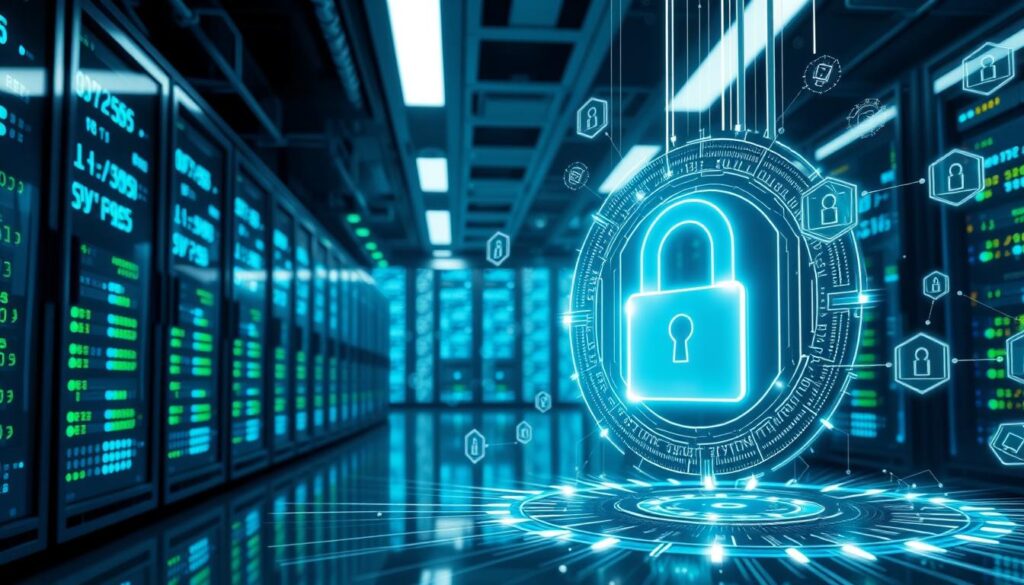
Timeline for Quantum Threat Materialization
The exact time when quantum threats will be real is not clear. But, the effect will be big. Quantum AI could help defend against cyber attacks in real time10. On the other hand, quantum tech could help hackers outsmart defenses, giving them an edge11.
| Aspect | Impact of Quantum Computing |
|---|---|
| Encryption | Threatens RSA and ECC systems |
| Blockchain | May compromise secure transactions |
| Machine Learning | Enhances pattern recognition and anomaly detection |
| Cybersecurity Gap | Widens disparity between nations with and without quantum infrastructure |
As we get closer to the quantum era, it’s key for governments and companies to focus on safe cryptography. This is the best way to get ready for these new cyber dangers11.
Critical Infrastructure Protection in the Digital Age
The digital age brings new challenges to cybersecurity, specially for critical infrastructure. With emerging technologies, protecting essential services is key. Recent attacks on water systems highlight how vulnerable our infrastructure is.
AI is changing how we defend critical systems. In 2023, GridGuard, an AI system, stopped a complex cyber attack in its first month. It analyzed millions of data points in real-time to find threats12. AI can work faster and spot patterns better than humans in protecting infrastructure12.
But AI isn’t perfect. Bad actors could trick AI systems by messing with their training data. This could create weak spots in our defenses12. Experts are working on new models to make AI more transparent and secure for Industry 5.0 critical infrastructure12.
Quantum computing is another game-changer. It’s set to become a $10.5 trillion industry by 202513. But it also poses risks. By 2030, quantum computers might be able to crack today’s encryption13. This puts long-term data at risk, like health records or mortgage contracts.
To face these challenges, new strategies are emerging:
- Zero-trust architecture: The US plans to invest $10 billion in this approach for federal systems14.
- IoT security: With over 41 billion IoT devices expected by 2025, securing these is key14.
- AI-driven solutions: These are growing fast, at 23% yearly through 202514.
Countries are taking action. The EU now requires cybersecurity certifications for IoT devices. Singapore has a labeling scheme for IoT security14. In the US, the CyberSentry program watches critical networks in real-time14.
As we move forward, protecting critical infrastructure will need constant innovation and vigilance. It’s a complex task, but vital for our digital future.
Emerging Attack Vectors and Defense Strategies
The cyberthreat landscape is changing fast, posing new challenges for cybersecurity experts. Companies face growing risks from advanced threats, weak supply chains, and unknown exploits.
Advanced Persistent Threats
Advanced Persistent Threats (APTs) are getting smarter. AI attacks and ransomware services are on the rise. State-backed attacks on energy systems have jumped by 72%, and 72% of firms see more cyber risks15.
Supply Chain Vulnerabilities
Supply chain attacks are a big problem. 54% of big companies say supply chain issues are their biggest cyber challenge15. Third-party software hacks have gone up by 54%, showing the need for strong supply chain security15.
Zero-Day Exploit Prevention
Zero-day exploits are a major worry. Companies are using AI to detect threats in real-time. This boosts their cybersecurity and helps them act fast against threats16.
| Threat Type | Increase | Impact |
|---|---|---|
| AI-generated phishing | 300% higher success rates | Enhanced social engineering effectiveness |
| Voice cloning attacks | 250% increase | Rise in identity fraud |
| Deepfake-based fraud | $1.2 billion in losses | Financial and reputational damage |
To fight these threats, companies are using new defense tactics. Those in shared defense groups see 43% better threat detection and 27% quicker response times15. AI in defense has cut false positives by 67% and sped up threat detection by 41%15.
The Evolution of Cybersecurity Workforce
The world of cybersecurity is changing quickly, leading to a big need for skilled workers. As cyber threats get more complex, having a strong workforce is key. Companies struggle to find and keep top cybersecurity talent.
Skills Gap Analysis
Today, the cybersecurity field faces a big challenge. Many companies can’t fill important roles, leaving them open to attacks. The skills gap is huge and getting bigger.
Cybersecurity experts say there’s a constant shortage of skills. This problem has gotten worse over the last two years17. Both private and public sectors are struggling to protect against new threats.
Training and Certification Requirements
New training and certification programs are popping up to help. They focus on the latest tech and threats. The need for soft skills like communication and problem-solving is growing too17.
Staying up-to-date is essential in this fast-changing field.
Future Job Market Projections
The future looks good for cybersecurity jobs. Gartner predicts that by 2026, 70% of corporate boards will have a cybersecurity expert17. This shows how important cybersecurity is becoming in business.
New roles are emerging, like AI security and quantum computing protection. The job market for cybersecurity is expected to grow as threats do. It’s estimated that cyber attacks could cost the global economy over $10.5 trillion by 202517.
This huge cost highlights the need for a skilled cybersecurity workforce to prevent these losses.
Regulatory Landscape and Compliance Requirements
The world of cybersecurity is changing fast, with new laws popping up everywhere. By 2025, companies will face a maze of rules from different countries18.
The European Union’s Digital Operational Resilience Act (DORA) will start on January 17, 2025. It will affect banks and other financial groups. At the same time, the EU AI Act will change how we handle AI and data privacy worldwide19.
In the U.S., NIST updated its risk management guidelines in 2024. The Payment Card Industry Data Security Standard (PCI DSS) 4.0 will make financial institutions check their systems more closely19. These rules aim to make companies more responsible for security and to improve standards.
Companies are using special dashboards to keep up with rules better. A big bank cut its compliance problems by 40% with such a system18. This move helps avoid mistakes and makes sure rules are followed on time.
The rules for cybersecurity are getting more complicated, thanks to new laws in the U.S. This has created a mix of rules that can be hard for Chief Information Security Officers to handle20. To deal with this, companies need to check themselves often, invest in people, and always be ready to improve security.
As new tech changes the cybersecurity world, rules are focusing more on being ready for cyber attacks. Companies must show they can keep going after an attack, which means they need strong plans18. Being ready for cyber threats means being active in both following rules and keeping systems safe.
Enterprise Security Architecture of Tomorrow
The future of cybersecurity is changing fast. New technologies are changing how we protect our digital world. As cyber threats get smarter, companies are using new security plans to keep up.
Zero Trust Framework Implementation
Zero Trust is key in today’s cybersecurity. It says no one or anything is safe by default. You must always check who and what you trust. Now, 60% of companies use Zero Trust, showing a big change in how they defend themselves21.
Cloud Security Integration
More businesses use cloud services, making cloud security very important. Hackers have used cloud services like Google Drive and Microsoft OneDrive for secret attacks22. To fight these threats, cloud security tools are expected to grow by 35% by 202521.
Identity Management Evolution
Identity management is getting a boost with new cybersecurity methods. Things like passwordless login and AI in biometrics are becoming popular. Companies using micro-segmentation see a 40% drop in attack risks, making their networks safer21.
| Security Measure | Adoption Rate | Impact |
|---|---|---|
| Zero Trust Model | 60% of organizations | Enhanced verification process |
| Cloud-Native Security Tools | 35% increase expected by 2025 | Improved multi-cloud security |
| Micro-segmentation | Growing adoption | 40% decrease in possible attack paths |
As cybersecurity changes, companies must update their security plans. By using Zero Trust, improving cloud security, and updating identity management, they can protect against future threats.
Investment and Market Growth in Cybersecurity
The cybersecurity world is growing fast, thanks to more and smarter cyber attacks. This field is now key for businesses, drawing in lots of money and growth.
AI is leading this growth. Companies using AI to spot threats saw a 35% drop in attacks in 2023. This shows AI’s power in keeping systems safe23. By 2025, 80% of big companies will use AI for security, up from 50% in 202323.
There’s also a move towards safer cloud tech and quantum-resistant encryption. By 2025, 60% of big companies will use quantum-safe encryption, up from 25% in 202323. This shows companies are getting ready for future security threats.
Looking at Israel’s tech scene gives us clues about global trends. In the first half of 2024, Israel saw $5.1 billion in private funding, with cybersecurity getting 52% of it24. Cybersecurity’s share in funding has jumped from 20% in 2018 to over 50% in 202424.
| Year | Cybersecurity Funding Share | AI Security Investment | Quantum-Resistant Encryption Adoption |
|---|---|---|---|
| 2023 | 20% | $2.67 billion | 25% |
| 2024 | 50% | $3.33 billion | 42.5% |
| 2025 (Projected) | 52% | $4 billion | 60% |
While cybersecurity investments are up, experts warn against putting all eggs in one basket. It’s smart to invest in other fast-growing areas like AI, quantum computing, and climate tech. This keeps the tech world strong and balanced24.
Conclusion
The future of cybersecurity is changing fast, thanks to AI, quantum computing, and more. We’re on the edge of a new digital era. The global quantum computing market is expected to grow a lot, with a 30% annual growth rate. It’s set to reach $64 billion by 203025.
Big names like Google AI, IBM, and Microsoft are leading the way in quantum computing. They’re making big steps forward. This is opening up new possibilities in many fields25.
Boeing is using quantum computing to predict when things might fail. This shows how it can make things safer and more efficient2526.
Cybersecurity is changing fast, and we need to keep up. Using AI and quantum-safe security is key. The quantum computing market is set to grow from $928.8 million in 2025 to $6.5 billion by 2030. It’s time to get ready for this big change in cybersecurity26.
Learning and working together are key to a safer digital future. The future of cybersecurity isn’t just about tech. It’s about how we adapt, innovate, and collaborate to make our digital world safer for everyone.
FAQ
How is AI transforming cybersecurity?
AI is changing cybersecurity by improving threat detection and response. It analyzes data quickly to spot threats and act fast. This makes organizations more secure than before.
What is quantum computing’s impact on current encryption methods?
Quantum computing could break many encryption systems today. This is why new, quantum-proof encryption is being created. It aims to keep data safe from future quantum attacks.
What are zero trust frameworks in cybersecurity?
Zero trust frameworks mean you never trust anyone or anything without checking. They make sure everyone and everything is verified before they can access anything. This is true whether they’re inside or outside the network.
How are geopolitical tensions affecting cybersecurity strategies?
Global tensions are making cybersecurity more challenging. Almost 60% of companies say these tensions affect their security. They’re focusing more on protecting key systems and getting ready for cyber attacks from countries.
What are some emerging attack vectors in cybersecurity?
New threats include advanced persistent threats, supply chain attacks, and AI-powered attacks. Ransomware-as-a-service is also growing. These threats mean companies must keep updating their defenses.
How is the cybersecurity workforce evolving?
The cybersecurity field is changing with new tech like AI and quantum computing. There’s a need for experts in AI and quantum security. Companies are also focusing on training to fill skill gaps.
What is the role of cloud security in modern cybersecurity architectures?
Cloud security is key as more companies use cloud services. It involves special security for cloud environments. This includes protecting data, managing access, and following rules in cloud settings.
How are regulatory requirements shaping cybersecurity practices?
Laws like GDPR and CCPA are making companies improve their security. They need to protect data better, report incidents clearly, and focus on privacy. These changes affect how companies approach security and follow rules.
Source Links
- 2025 Cybersecurity Trends – https://www.nucamp.co/blog/coding-bootcamp-cybersecurity-2025-2025-cybersecurity-trends
- From AI to Quantum Computing: The World Economic Forum’s Cybersecurity Outlook – https://complexdiscovery.com/from-ai-to-quantum-computing-the-world-economic-forums-cybersecurity-outlook/
- From AI Phishing to Quantum Risks Mastering Cybersecurity – https://www.strongestlayer.ai/blog/from-ai-phishing-to-quantum-risks-mastering-cybersecurity-in-the-age-of-intelligent-threats/
- Cybersecurity in the Quantum AI Era – https://www.aiplusinfo.com/blog/cybersecurity-in-the-quantum-ai-era/
- Quantum Computing, AI, and Cybersecurity: How the Future of Technology Impacts Your Today’s Digital Safety – https://www.linkedin.com/pulse/quantum-computing-ai-cybersecurity-how-future-technology-impacts-rqejc
- The Future of Cybersecurity: A 5-Year Outlook – https://www.profbanafa.com/2024/10/the-future-of-cybersecurity-5-year.html
- Quantum AI: The Future of Cybersecurity – https://www.kiteworks.com/kitecast/quantum-ai-the-future-of-cybersecurity/
- The Evolution Of Artificial Intelligence In Cybersecurity – https://www.vc3.com/blog/the-evolution-of-artificial-intelligence-in-cybersecurity
- What are Predictions of Artificial Intelligence (AI) in Cybersecurity? – https://www.paloaltonetworks.com/cyberpedia/predictions-of-artificial-intelligence-ai-in-cybersecurity
- Quantum Computing and AI: The Next Frontier in Cybersecurity – https://www.linkedin.com/pulse/quantum-computing-ai-next-frontier-cybersecurity-samuel-a-adewole-4ugzf
- Quantum computing and the Cybersecurity crossroads: A new era of threats and opportunities – https://www.linkedin.com/pulse/quantum-computing-cybersecurity-crossroads-new-era-schneider-dgjac
- AI in Critical Infrastructure Protection: Guarding the Pillars of Modern Society – https://www.linkedin.com/pulse/ai-critical-infrastructure-protection-guarding-pillars-adewole-wk1uf
- The Future of Cybersecurity in the Age of Quantum Computers – https://www.mdpi.com/1999-5903/14/11/335
- Cybersecurity in the age of AI: Preparing for 2025 and beyond – https://www.tbsnews.net/thoughts/cybersecurity-age-ai-preparing-2025-and-beyond-994586
- Global Cybersecurity Outlook 2025: Navigating Complexity and Building Resilience | WEF Report Analysis – https://guptadeepak.com/the-future-of-cybersecurity-global-outlook-2025-and-beyond/
- The Evolution of Cybersecurity: Emerging Threats and Defense Strategies for 2025 – https://medium.com/@londondataconsulting/the-evolution-of-cybersecurity-emerging-threats-and-defense-strategies-for-2025-5f5da2f5462e
- Cogent | Blog | The Evolution Of Cybersecurity: Key Trends And Technologies In 2024 – https://www.cogentinfo.com/resources/the-evolution-of-cybersecurity-key-trends-and-technologies-in-2024
- How Regulatory Compliance Shapes Cybersecurity Priorities – 2025 and Beyond – https://www.linkedin.com/pulse/how-regulatory-compliance-shapes-cybersecurity-priorities–pg00c
- How will rules and regulations affect cybersecurity and AI in 2025? – https://www.scworld.com/feature/how-will-rules-and-regulations-affect-cybersecurity-and-ai-in-2025
- The Shifting Sands and Paradoxes of Cybersecurity for 2025 and Beyond – https://www.picussecurity.com/resource/blog/the-shifting-sands-and-paradoxes-of-cybersecurity-for-2025-and-beyond
- Future Trends in Cybersecurity: Navigating Tomorrow’s Digital Landscape – https://www.linkedin.com/pulse/future-trends-cybersecurity-navigating-tomorrows-digital-ryan-shah-xqp8e?trk=public_post
- With AI, It’s a Complex Future for Cybersecurity – RTInsights – https://www.rtinsights.com/with-ai-its-a-complex-future-for-cybersecurity/
- Top 10 Cybersecurity Predictions for 2025 & Beyond.. – https://www.linkedin.com/pulse/top-10-cybersecurity-predictions-2025-beyond-malini-1jfqc
- Beyond cybersecurity: Securing Israel’s future as the Startup Nation | CTech – https://www.calcalistech.com/ctechnews/article/hkfy93ekr
- Quantum Computing Era is Here and Growing: The Dawn of Practical Artificial Intelligence (AI) and Cybersecurity Applications – https://www.globenewswire.com/news-release/2025/01/09/3006772/0/en/Quantum-Computing-Era-is-Here-and-Growing-The-Dawn-of-Practical-Artificial-Intelligence-AI-and-Cybersecurity-Applications.html
- UPDATE – Quantum Computing Era is Here and Growing: The Dawn of Practical Artificial Intelligence (AI) and Cybersecurity Applications – https://www.morningstar.com/news/globe-newswire/9329980/update-quantum-computing-era-is-here-and-growing-the-dawn-of-practical-artificial-intelligence-ai-and-cybersecurity-applications
